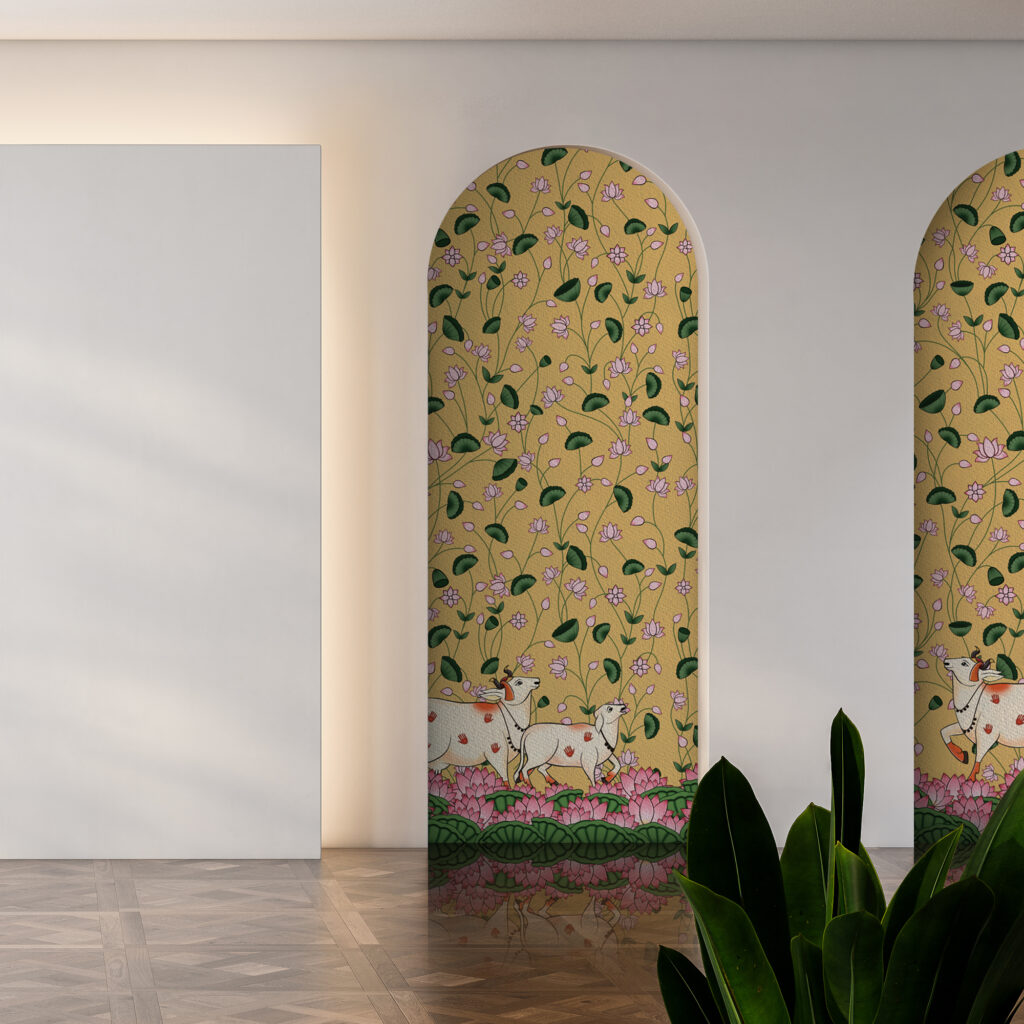
- The lotus has outdone timelines and cultures through its extensive symbolism in religion, philosophy and art. Emerging as a bright and unwavering beauty from the mud, the lotus forms analogies with purity, divinity and reform.
- Asian civilizations have used the lotus flower’s timeless beauty to grace their culture for millenniums.
- The earliest mention of the lotus in the Indian subcontinent is seen in the Vedas, where the god of fire – Agni is said to emerge from a lotus blossom. Vedic tales often suggest the lotus as the flower from which all creation originates.
- The origin of the lotus in Hindu mythology can be traced through stories of ‘Samudra manthan’ where it emerged with goddess Lakshmi seated on a fully bloomed red lotus. This made the lotus a prominent symbol of wealth, prosperity and divine purity. It attaches itself to feminine grace and knowledge through its depiction with the goddess Saraswati.

- One of the oldest physical depictions of the lotus can be dated back to the 5th century in the ancient sculptures of the Chalukya dynasty. Brahma – the creator, also called Prajapati is found alone resting on a lotus leaf with the desire to create this world.

- In the ancient caves of Ajanta, we find several murals dating back to the late 5th century. These carved wonders were monasteries of the time and were decorated with carvings and paintings depicting the life of Buddha. Bodhisattva Padmapani is one of the late works from the cave which depicts a young man holding a lotus in his hand. (Bodhisattva – One on the path of enlightenment; Padmapani – One who holds a lotus in his hands) This is an excellent example of realism in painting which was unseen in that era. The Bodhisattva painting is an important insight into early Buddhism and one of the finest and earliest depictions of the lotus flower.
- Not only is it just an element, but the central focus is where the subject is cast around the flower. The lotus naturally defines the character of the deity as delicate, youthful and calm. The values of Buddha shine through the metaphor of a lotus and also give it a symbolic value in the culture and myths surrounding Buddhism.
- Even before the birth of Gautam Buddha, his mother is said to have dreamt of a white baby elephant carrying the lotus bud in the form of a baby.
- It is said that lotus flowers emerged as Buddha in his child form took steps on the earth. Therefore it becomes a central element in the visual and literary associations of Buddhism.
- Ancient Egypt also used the white Lotus in paintings depicting rebirth, after-life and creation. Egyptian society celebrated death as much as living and the white Lotus became a popular offering to the gods that would grace them in their afterlife.

Lotus in Art
- Chinese and Japanese art forms use the lotus motifs in intricate carvings and porcelain paintings making it a popular design element. The lotus serves as a powerful and multifaceted symbol in the Asian continent and its intertwining cultures, representing spiritual purity, enlightenment, harmony, and the enduring beauty that can arise from challenging circumstances.



- In India, lotus has been an early presence in the Indus Valley civilization. It gained popularity as a symbol and decorative element. Excavations at Indus had found lotus leaf-like motifs on ceramics and terracotta seals. A mother goddess figurine found in Mathura had distinctive curved lotus motifs indicating the rising fame of the flower. It was something that the artisans of the time observed and deemed beautiful enough to add to their recurrent works. With a deep connection to folk art, the lotus flower was abundantly used in miniatures and mandala styles of art. Its beauty also graces depictions of mythological scenes or gods in folk and religious paintings and carvings.
- While the lotus flower is not native to Europe and does not hold the same cultural or religious significance in European traditions as it does in Asian cultures, it has still made its way into European art over the centuries.
- As trade routes expanded and explorers brought back exotic plants from Asia, detailed botanical illustrations became popular in Europe where artists explored its delicate form and beauty. Eastern subjects, such as the lotus, captivated European artists, especially during the 19th-century Orientalist movement. It was depicted in romanticized scenes from Asian cultures.
- Even though the lotus may not have the same depth of cultural and religious symbolism in European art as it does in Asian art, it has been appreciated for its aesthetic qualities and exotic allure. European artists have incorporated the lotus into their works, sometimes as a decorative element and at other times as a symbol with broader spiritual or philosophical connotations.
The lotus stays dear to artists, poets, writers and admirers of art due to its versatility. The testimony of unparalleled beauty possessed by the lotus is evident and continues to inspire modern design with its simplicity yet stunning form.
We at Jumig are equally fond and our creations reflect it.
Canvas
- Lotus motifs feature frequently in our collection of canvas paintings, which range from traditional pichchvai designs to striking pink lotuses with gold embellishments. The delicate appearance of the lotus blossom also serves as inspiration for our abstract creations. The brightly coloured piece works well in living rooms, casual office spaces, and lobby decor, while traditional frames work best in kitchens and pooja rooms. The lotus with gold blossoms on a dark blue background is a suitable piece for professional areas that combine elegance and strength.
- Our circular paintings on canvas are a unique collection of pieces that capture attention through their shape and delicate artwork. The stained lotus against big lilypads and a fainting evening sun bring the beauty of oriental charm to any space. The lotus emerging in an exotic foreground gives your space a tropical and inviting vibe.
Wallpaper
These simple and recurring lotus patterns, which draw inspiration from the block printing methods used in traditional Indian textiles, can bring harmony and balance to a space.
A stylish and well-composed appearance can be achieved using wallpaper featuring lotus motifs in a single colour or tonal palette.
This allows the lotus design to stand out without being overpowering. A lighter colour scheme provides a minimalist look, but a darker background with detailed prints alludes to a sophisticated charm.
Opt for wallpapers with watercolour lotus motifs. Watercolour designs can give a more contemporary look, creating a soft and calming atmosphere. Adding greens and yellows from leaves balances out the overpowering pinks from the lotus.
The fading and translucent glass-like wall covering translates to a fine depth to your spaces.
Select wall coverings with traditional lotus designs, influenced by Indian painting styles such as pichchwai. These frequently feature complex, repeating lotus patterns with a rhythmic movement, highlighted in vivid hues like pink, blue, and yellow. They frequently feature peacocks, picturesque backdrops, cows and other folk elements.
Frame Sets
With traditional arts, our popular frame sets depict lotuses in a folk scene of do saheliya, where they function to accentuate women’s beauty and infuse your room with a youthful vibe.
Another famous scene is Padma on Water, in which a lone lotus blossoms amid the geometric chaos of the birds and water. The solitary pink lotus becomes the centre of attention, while the blue maintains subtlety.
These sets are ideal for adding charm and vibrancy to monotonous spaces.
Wall Murals
Murals are art pieces designed to draw attention to a wall’s features. To give your area the quality you want, we work with variety of materials and create unique multi-media designs.
The delicate nature of the lotus is captured in stone and metal to create a one-of-a-kind sculpture that flawlessly combines the lotus’s essence wih modern elements.
Opting for wallpapers with textured lotus motifs, such as embossed or raised patterns can give the walls more character and depth, giving the space a more tactile feel. Mint sandstone is versatile in complementing a variety of backdrops and can be a go-to for a minimal yet artistic installation.
These are perfect as foyer or living room pieces for a touch of luxury.
Alternatively, the red sandstone gives your home a more traditional earthy element. Simplistic artwork such as the hand of Vishnu or the Ganesha with a golden lotus bud can serve as a modern homage to spirituality. Using brass and gold-like finishes gives a glamorous touch that complements a variety of colour palettes.

















